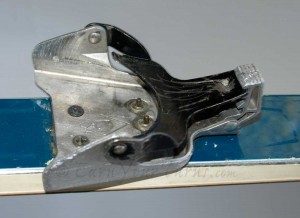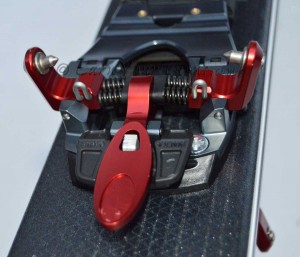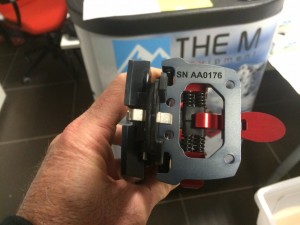“Ask and you shall receive,” goes the saying. We all know that isn’t always true, but it is often enough to keep the quip alive. In this case, it is true. For years tech savvy telemarkers have dreamed of a lightweight binding with Dynafit touring efficiency and a powerful NTN connection to the boot. With the delivery of Meidjo, the first design from French manufacturer the M-Equipment, the brainchild of Pierre Mouyade, that day has arrived.
![Meidjo: < 1 lb./binding, free-pivot, NTN compatible, step-in, releasable, and powerful.]()
Meidjo: < 1 lb./binding, free-pivot, NTN compatible, step-in, releasable, and powerful.
Requires 1) Faith in the 2-pin tech toe and 2) an early adopter license.
Last spring a video of a prototype telemark binding began circulating on the internet showing a binding with a low-tech toe and a spring-loaded plate that attached to the 2nd heel of a Scarpa TX-Pro. Skepticism ran as high as optimism for two reasons. First, that it would make it to market as early as claimed, by late 2014, and two, that it would ski very well. The first production bindings were delivered in December 2014, fulfilling the delivery claim. After a mere two short tours I can verify, it skis as well as promised, both uphill and downhill.
![Meidjo, fresh from the factory.]()
Meidjo, fresh from the factory.
My first impression of Meidjo was of surprise at how professional it looked and felt. Over the years I’ve become accustomed to spartan simplicity, not just in the look and functionality of telemark bindings, but in their presentation. Meidjo came in a box with a classy looking illustration of the binding on the outside, and a well organized presentation of the pieces inside. This binding was clearly a well crafted piece of engineering with molded parts and plenty of attention paid to the details. While some pieces of the product are currently missing, such as ski brakes or crampons, their future inclusion has already been accounted for even in this first generation version.
The Low-Tech Toepiece
![Meidjo's low-tech toe has alignment bumpers and stands 2mm higher than other tech pins with true lock out for touring.]()
Meidjo’s low-tech toe has alignment bumpers and stands 2mm higher than other tech pins with true lock out for touring.
The toepiece uses the classic 2-pin, low-tech design pioneered by Dynafit, but with a few modifications to make it easier to get in to, and more appropriate for telemarking. As many others are doing, Meidjo provides two tabs of bent wire to align the front of your boot against when stepping in. To further improve alignment and improve your odds of clicking in the first time, the pins are 67mm apart when open, just a few millimeters wider than your boot. The springs used on the toe jaws are twice as strong as Dynafit springs, so the jaws close with a resounding snap, and require more force to pry apart – something any thinking telemarker knows will benefit them when making turns.
To account for different thickness soles of NTN boots the height of the toe pins are 2mm higher than classic Dynafit pins, so the lugged soles of thicker boots won’t contact the base of the toe plate and interfere with release.
When touring, the jaws can be locked shut, not by pulling up on the metal bar in front, but by pushing down on a plastic piece that moves a metal tab under the release bar preventing it from moving down and opening the pin jaws. The beauty of this system is two-fold. First, you switch between walk or tele modes using your ski pole, without having to bend over. Secondly, it doesn’t just increase the resistance to opening, it prevents the jaws opening. In my maiden tour I was traversing icy slopes that mandated repeated stomping. I released only once, because I had forgotten to lock the jaws shut. Once locked, they stayed shut, even with repeated, aggressive stomping to hold an edge.
Step-In
![To step in, first cock the baseplate into position by lifting it until the red bar seats in the bumper.]()
To step in, first cock the baseplate into position by lifting it until the red bar seats in the bumper.
Besides clicking in relatively easily to the toe pins, attaching the plate to the duckbutt is an easy, relatively intuitive procedure as well. To do that you must first cock the spring plate into position by lifting it up so the red bar, underneath the spring housing, between the springs, rests on the black plastic plate suspending at about 30 degrees. With the pins snapped on the toe, lower your heel until you feel, and hear, the housing catch around the duckbutt. Slowly lower your heel until you feel the plate slip more solidly over the second heel, then raise your heel a bit to pull the plate tighter until you hear the housing snap tight around the duckbutt. There is a little red tab in the middle that needs to be pushed back, causing the spring housing to snap solidly on to the boot. Lifting your heel a bit will trigger it to latch on. You are now fully connected to Meidjo and ready to rip some turns.
Downhill Power
As yet I haven’t done a true side-by-side comparison but experience suggests the Meidjo is equivalent to HH#3 or 3½. Not the most active binding available, but no slouch either and probably the activity level that most telemarkers prefer. It is certainly active enough to hold a solid edge on hard pack, and not so active that it will cause excessive tip dive in soft snow. The actual cable pivot position is about 60mm behind the toe pins, which is approximately the same as the forward position of a TTS binding.
While the pivot location of the “cable” is fixed, you can increase spring tension simply by tightening the lugs holding the springs on the cable bar. When I say Meidjo has a tension of approximately HH#3, that is for a lightly tensioned spring, or a setting of 2 out of 5 per Meidjo’s scale. If you want even more tele-resistance, a second set of springs is available that can be added in parallel (inside) the stock springs to increase the baseline activity of telemark tension.
Safety Release
In theory Meidjo offers a safety release, a combination of an adjustable spring tension on the side wings that hold the second heel, and the spring tension of the pins. In my limited number of runs I did not experience any release, nor should I have. At this moment it certainly isn’t certified, but like most telemark binding release systems, probably works. I can confirm it did release laterally with a kick from the side aimed at the back of the boot. In due time reports from the field will confirm or deny the “safety” aspect of Meidjo’s release system. The release tension is adjustable with a 3mm allen wrench to increase or decrease spring tension on the wings holding the sides of the duckbutt.
Exiting the binding
As with nearly any other tech binding, press the front toe lever down to open the jaws. Lift the toe of your boot a bit, then twist it to unhook the duckbutt from the binding plate.
![Features of the Meidjo telemark binding]()
Features of the Meidjo telemark binding
Touring Efficiency
As you might expect, with a 2-pin tech toe this is a very efficient binding for skinning since you only lift your boot when striding. However, to lock the plate out of the way so it doesn’t flop around or inadvertently latch onto your boot you must hook a wire over the central red bar to hold the plate down. This is a small wire hoop that requires finger dexterity to move. Not a big deal, except it means you must exit the binding to latch the plate flat, but you needed to do that to put your skins on anyway, right? To unhook the plate when you’re ready to rip the hide and make some turns Meidjo provides some tape to attach to the wire hoop so you can pull it back and release it. Except the tape is weak and mine tore the very first time. A better mousetrap is in the works for this function, but in the meantime I suggest substituting a strip of fiberglass reinforced strapping tape (Scotch brand 893-JPK) that is stronger and will last longer.
At just under 1 pound per foot (430 g or 15.2 oz/foot, size Lg), you’ll love how little this binding adds to your total drag weight.
The heel post is one of the weak ingredients of this binding. It is a simple plastic post that flips up easily with your ski pole to provide an angle of 7° or, flip up a secondary wire for a higher climbing angle of 13°. These are pretty common heights, but unfortunately, the posts are prone to collapsing under pressure. A cure is in the works, but not available at the moment. In the short term, consider making peace with a low-angle, meanderthal skin track. ![;)]()
Mounting
![To access the rear mounting holes the baseplate must be partially disassembled. Hint: When reassembling, it is easier to thread the spring knobs on when the baseplate is flat.]()
To access the rear mounting holes the baseplate must be partially disassembled.
Hint: When reassembling, it is easier to thread the spring tensioning knobs on when the baseplate is flat.
It would be unrealistic at this stage to expect a jig for mounting this binding. Instead Meidjo comes with not one, but two, adhesive mounting templates that you can affix to your ski for drilling. Even with these convenient templates I would be remiss to not remind you the
Carpenter’s Rule still rules, and only caution users to double-check that they set an accurate, precise center line down the middle of the ski before placing the templates for drilling.
Equally important is reviewing all the pieces of the binding because some assembly IS required and you need to understand where each part goes before you start drilling and screwing things together, hopefully in proper sequence and position, not screwing them up. The English directions are clearly a translation so you are advised to proceed with caution. If you’re not mechanically inclined, find someone who is to mount Meidjo for you.
Caveats
As this is a first look at a first generation binding many, if not all, the issues raised below will inevitably cease to be a concern in succeeding generations of this binding. For the moment, they are valid.
Although Meidjo does not yet offer ski brakes the holes to attach them to the binding already exist. They’re located between the cable pivot and the toepiece. These are scheduled to be available later this season.
Likewise for ski crampons. There is a set of brass inserts on top of the plate, just behind the cable pivot where a crampon clip will be attached. The clip will work with Dynafit compatible crampons.
For those on the Wet Coast, some icing is bound to occur. So far the only icing I noticed was snow packing in the cavity where the 2nd heel sits, which prevents switching from tour to tele mode without taking a moment to clear it out. It might mean you have to step out of the binding before you can step back in. Expect a round of heckling from your friends with Switchbacks.
The stainless steel toe pins of tech bindings are typically pressed into the arms or jaws of the toe piece. In the current version of Meidjo the pins fit tight, but are actually held with epoxy around their circumference plus a snap ring on the outside. Next years production run will be press fit like other tech bindings.
It is also worth noting the pins do not have ice cutting slots in them. Whether those will be added sooner or later remains to be seen. They aren’t on all tech bindings, but most.
![Until next the production run, keep your eye on the pins that hold the toe jaws, the base plate, and the mode switch.]()
Until next the production run, keep your eye on the pins that hold the toe jaws, the base plate, and the mode switch.
The biggest concern is the tendency for five critical pins that hold the pin locking switch (1), the toe jaws (2), and the plate to the toe piece (2) to work themselves out. In a mere two tours the pins holding the toe jaws on one binding (but not the other) had worked themselves out by 2-3mm. It was a simple operation to tap them back in to place, but be aware you might need to. A modification is in the works to prevent this happening. For the moment though, best to watch ‘em like a hawk and be prepared with something to tap ‘em back in.
The durability of the baseplate is categorically suspect because of its plastic composition. It looks well made but only time will tell if it can go the distance.
Conclusion
If you’ve been holding out on upgrading your duckbilled telemark rig to the duckbutted NTN because it didn’t offer any clear advantages, the arrival of Meidjo is about to change that. Admittedly it needs a tweak or two but even at birth it offers excellent skiing performance, superb touring efficiency thanks to a 2-pin tech toe and seriously light weight, plus step-in convenience and even (albeit unproven, uncertified) safety release. Now, if you also want a lower price you’ll have to be content with what you have a while longer. Actually, when you consider that heavier tech bindings are about the same price, but they don’t tele for squat, the price is competitive. If you’re ready to embrace the future, and can afford the bruises that come on the bleeding edge of innovation, the future of tele is here today.
M-Equipment
Meidjo
MSRP: ~ $550* (€449)
Weight/binding (sz Lg): 15.2 oz. (430 g)
* – based on $ to € exchange rate on 05Jan15.
Related Posts
BCTalk discussion on Meidjo
© 2015






















































































